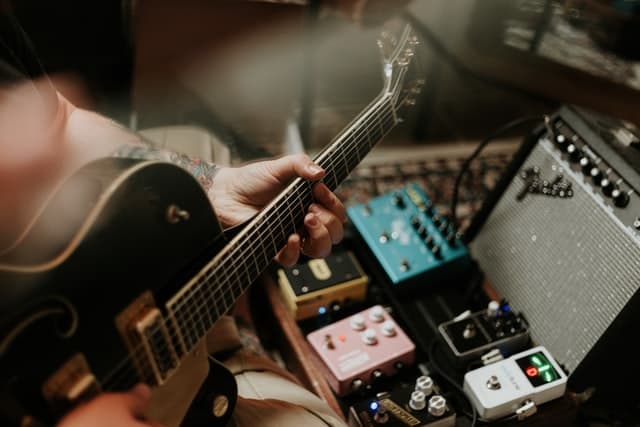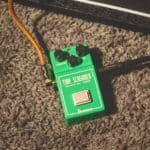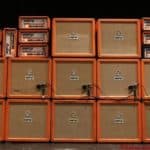While overdrive pedals have been around forever, it has become increasingly common to hear and read about amp attenuators among gearheads.
But most of the popular models are not cheap and before you invest your money it is best to look at all the alternatives.
Who knows?
In five years attenuators could be nothing but a fad from the past as gear evolves with even newer technologies.
Overdrive pedals offer more flexibility at a fraction of the price of attenuators, however, they can only drive the preamp section. Attenuators allow you to get overdrive by cranking the amp and making the power stage saturate. This works great for certain amps and tones.
I don’t think there is any reason that you couldn’t use an attenuator with a solid-state amplifier but since we are focusing on getting an overdriven sound that means we will be talking about tube amps, which begin to distort as you crank the volume.
The world is changing quickly with a growing population and a huge increase in urban living.
Basically, playing through the high-wattage tube amps that were so popular in past decades has become less practical for most of us.
And while a lot of musicians are switching to software and computer interfaces with monitor speakers, sometimes the past is hard to let go of and people still want stadium-sized amps too.
Hopefully, some of this information will help you decide if an attenuator is the right choice for you or if an overdrive pedal will suit you better.
Maybe there is a third option as well?
What is a guitar amp attenuator?
If you are not sure exactly what an attenuator does, it is basically a choke for the output of the amplifier.
It is placed between the amplifier’s output jack and the speaker(s) and bleeds off some of the voltage being sent to the speaker(s), usually transforming the excess energy into heat.
It can be used easily with a head/cabinet setup and with combo amps provided there is a ¼” output between the amp and the speaker(s).
Its main function is simply to allow you to lower the volume of high-wattage amps for use at home but this gives you the option of turning your amp volume/gain up to overdrive your amp without the actual volume disturbing your neighbors.
The big thing about attenuators is that you can get power stage saturation at bedroom levels because the amp will still be running hot.
This is great for certain kinds of amps, such as plexis, that really shine when the power section starts barking.
Now, for more modern metal-oriented units, where most (if not all) of the “important” distortion is generated in the preamp, unless they are voiced in a way that volume makes them sound better, attenuators don’t have a lot to add.
Does amp overdrive sound better than pedals?
I will admit it is a subjective matter to debate whether amp overdrive or pedal tones are superior but I have to give the edge to amplifiers with a big caveat.
Here is a video of a Marshall Super Lead with an attenuator being used at different strengths:
Now the amplifier sounds amazing at the highest volume but the quality goes down as the attenuator reduces the volume more.
And the speaker cabinet is microphoned for recording so it isn’t the same as being in the room.
But I think if you want to play at a very low volume you may prefer an overdrive pedal.
You can take a listen to the popular Boss Super OverDrive and Ibanez Tube Screamer pedals here:
They sound pretty good and I would probably prefer them over an attenuated amp at super low volumes, but they are also never going to compare to a cranked amp with no attenuator.
Listening to music and hearing the vibrations is one thing but I think that in a live loud setting, the vibrations and air being pushed by speakers affect more than just your ears; think about how when someone hits a bass drum you can feel it in your chest.
So I think playing a high-wattage amp with an attenuator or at a very low volume with pedals is a bit like driving a sports car during rush hour in the city.
Can you use overdrive pedals with an attenuated amp?
There is no reason that you can’t use both overdrive effects and an attenuator at the same time. But you should probably keep your amplifier’s volume low/clean and let the pedal do its job since it is overdrive we are discussing.
If you want to crank your tube amplifier and use an external overdrive on top of it then maybe it’s time to check out distortion pedals or amps with dirty channels.
Is a guitar amp attenuator a substitute for an overdrive pedal?
So you can use attenuators to overdrive your amp at low volumes with varying levels of success but pedals can do a little more.
If you are in love with your amp’s overdriven tone and use it consistently you are good to go.
But if you want to tweak the sound then a pedal’s controls can be useful especially if you are playing with others and having trouble cutting through the mix.
Also, if you just like noodling and using the same tone all the time, the attenuator is great and you can use your guitar’s volume to control it a little, but if you are playing actual songs that need overdrive for the chorus, solo, etc., then being able to engage it with your foot is a really useful feature.
Which one should you get?
There is a huge difference in price between the two options discussed here. You can easily pick up an overdrive pedal for under $100 and use it on any amp that you want.
And there are some cheap options for attenuators too but most of the popular models from brands like Two Notes and Rivera cost between $250 and $950.
If you already have a large tube amp then maybe an expensive attenuator is worth it to you but at that cost, I would consider a totally different option.
I prefer the tone of overdrive pedals to attenuated tube amps but don’t forget about low-wattage tube amps either.
Personally, I would suggest saving your 100-watt amp for gigging and putting your money towards a nice 5-watt amp that you can crank for playing at home.
Sometimes the best solutions are the simple ones.

Hello there, my name is Ramiro and I’ve been playing guitar for almost 20 years. I’m obsessed with everything gear-related and I thought it might be worth sharing it. From guitars, pedals, amps, and synths to studio gear and production tips, I hope you find what I post here useful, and I’ll try my best to keep it entertaining also.





